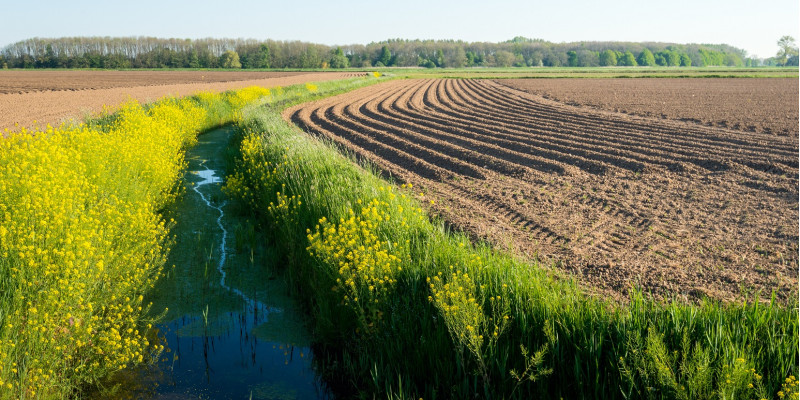What is needed in future is regular monitoring of small water bodies and systematically collected data on plant protection product use. This will enable us to measure and improve the environmental impact of agricultural use of pesticides and the effectiveness of protective measures. Already, the results show that vegetated water margins should be established everywhere to protect aquatic environments.
Focus on water bodies in the agricultural landscape
In 2018/2019, more than 100 stretches of water in the immediate vicinity of agricultural land were investigated in the small water body monitoring programme. These streams are the habitat of numerous animals and plants and they transport pollutants further into larger bodies of water, which then also play a role in the production of drinking water for humans. For this reason, even small bodies of water in the agricultural landscape should be as free of pollutants as possible and be in a good ecological condition.
However, researchers at the Helmholtz Centre for Environmental Research (UFZ) in Leipzig were able to clearly show that in reality far higher amounts of pesticides enter water bodies than predicted. In every second water sample, active substances used in plant protection products exceeded the acceptable concentrations. In addition, the pesticide residues have a far greater impact on the animals and plants in the water than previously assumed. The insect populations were found to be in a moderate to poor condition in four out of five streams investigated.
For the first time, the application data of the farms at ten monitoring sites were also evaluated. The more pesticides were used on the surrounding fields, the more heavily the waters were polluted with pesticide residues. The team led by Prof. Dr. Matthias Liess was able to show that a significant part of the pesticide contamination enters the small water bodies after or during rainfall. Surface runoff from fields is a major contributor and also occurs via ditches that only carry water intermittently. Water margins can reduce this surface runoff.
Permitted but still harmful to the environment
In the approval process for plant protection products, possible environmental impacts are considered. Based on model assumptions and laboratory tests, predictions are made here about the fate of the active pesticide ingredients in the environment. At the same time, measures to protect the environment are defined. However, these mandatory measures, which are supposed to prevent surface runoff, do not seem to have the expected effect in practice. In some cases, such measures are completely absent for some older plant protection products. New knowledge about the risks of individual active substances or new assessment methods are not applied quickly enough to existing plant protection products. Also, the models and assumptions of the authorisation process seem to significantly underestimate the real exposure to pesticides. The authors of the small water body monitoring programme therefore criticise numerous gaps in the authorisation of plant protection products, as well as existing exemptions from the measures that are actually supposed to protect aquatic environments.
Monitoring and application data are urgently needed
Before the small water body monitoring programme, there was no nationally representative data on pesticide residues in water bodies. The same was true for the ecological status of small water bodies in the immediate vicinity of fields where pesticides are applied. Also, farm records on pesticide uses in spray logs have not been published so far and are therefore not available to researchers and the authorities. Without data on pesticide use and protective measures that have actually been implemented, the sources and causes of pollution cannot be adequately investigated and assessed, and farmers often face blanket criticism of their agricultural practices.
Better protection of water bodies in the agricultural landscape
The small water body monitoring studies prove that pesticides do not only have an effect on the area of application. Pesticide residues cause damage in small bodies of water that has not been adequately prevented so far, despite authorisation and protective measures. All stakeholders involved in plant protection products and aquatic environments are called upon to contribute to the necessary improvement: through the rapid introduction of new knowledge into the authorisation process, through the continued monitoring of small bodies of water, through the systematic collection of meaningful application data, through studies on the effect of protective measures and through the implementation of effective measures in the field. The German Environment Agency considers permanently vegetated water margins on all small water bodies in the agricultural landscape – but without the exceptions that have been common up to now – to be effective.
Further information:
The new report on small water body monitoring further classifies the findings of 2018/2019. For the first time, the actual records of the farmers in the catchment areas of the water bodies were available for the assessment.
For this representative survey of the pollution of small water bodies, the German Environment Agency, together with the Helmholtz Centre for Environmental Research, investigated streams in the immediate vicinity of agricultural land after rainfall events throughout Germany in the years 2018/2019.
The European Commission's draft regulation on the sustainable use of plant protection products puts the EU's pesticide reduction targets into concrete terms and sets the course for sustainable agriculture. To this end, the German Environment Agency has submitted proposals on how the reduction targets can be reconciled with agriculture and thus also help to protect aquatic environments.
 Click to enlarge
Click to enlarge
